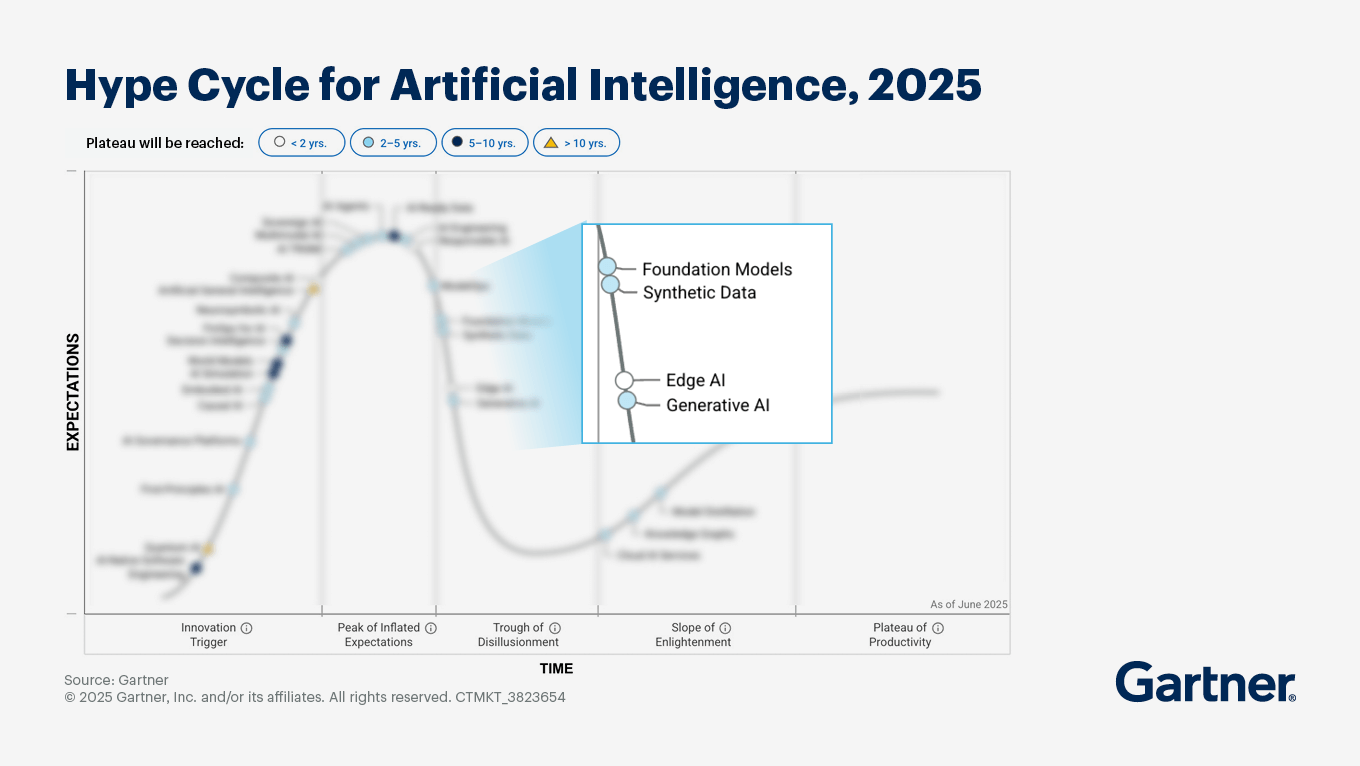The focus is shifting from the hype of GenAI to building foundational innovations responsibly.
- Gartner client? Log in for personalized search results.
The 2025 Hype Cycle for Artificial Intelligence Goes Beyond GenAI
By Haritha Khandabattu | July 8, 2025
The Hype Cycle for AI helps leaders prioritize high-impact, emerging AI technologies
With continued, steady investment in and adoption of AI, organizations have shifted to scaling AI with a focus on foundational innovations. The 2025 Hype Cycle for Artificial Intelligence helps leaders prioritize high-impact, emerging AI techniques, navigate regulatory complexity and scale operations.
Gartner produces more than 130 Hype Cycles every year to help clients track the maturity and potential of over 1,900 innovations in different segments, including industries, functions and regions — as well as technological domains. Find a sampling of the insights from one of our most popular AI Hype Cycles below.
Key takeaways from the Hype Cycle for Artificial Intelligence
Use the Hype Cycle to identify which key technologies you need to continue innovating with AI while shifting from experimentation to scale.
Gen AI enters the Trough of Disillusionment
Despite ethical and societal concerns, last year’s Hype Cycle for AI highlighted GenAI as a potentially transformational technology with profound business impacts. This year, GenAI enters the Trough of Disillusionment as organizations gain understanding of its potential and limits.
AI leaders continue to face challenges when it comes to proving GenAI’s value to the business. Despite an average spend of $1.9 million on GenAI initiatives in 2024, less than 30% of AI leaders report their CEOs are happy with AI investment return. Low-maturity organizations have trouble identifying suitable use cases and exhibit unrealistic expectations for initiatives. Mature organizations, meanwhile, struggle to find skilled professionals and instill GenAI literacy.
More broadly, organizations face governance challenges (e.g. hallucinations, bias and fairness) and government regulations that may impede GenAI applications for productivity, automation and evolving job roles.
Pinpoint high-impact AI opportunities with Gartner’s AI Use Case Insights for IT Leaders. Discover, evaluate, and prioritize AI opportunities to accelerate IT transformation and demonstrate value to the business.
Invest in key foundational AI enablers
As organizations gradually pivot from GenAI as the central pillar of their AI programs, they’re focusing on enabling technologies that support sustainable AI delivery. These technologies help streamline the integration and management of AI systems to make them effective and scalable.
For example, AI engineering, which enables organizations to establish and grow a high-value portfolio of AI solutions consistently and securely, is the foundational discipline for enterprise delivery of AI and GenAI solutions at scale.
Another key foundational technology — one that is ultimately expected to reach the Plateau of Productivity — is model operationalization (ModelOps). With its focus on the end-to-end governance and life cycle management of advanced analytics, AI and decision models, ModelOps helps standardize, scale and augment analytics, AI and GenAI initiatives and move them into production.
Two key AI technologies are on the move
Further supporting the shift in focus toward foundational AI technologies, the two biggest movers on this year’s Hype Cycle are AI-ready data and AI agents. Both sit at the Peak of Inflated Expectations.
To scale AI, leaders must evolve data management practices and capabilities to ensure AI-ready data — determined through the data’s ability to prove its fitness for use for specific AI use cases — can cater to existing and upcoming business demands. However, 57% of organizations estimate their data is not AI-ready. Organizations without AI-ready data will fail to deliver business objectives and open themselves up to unnecessary risks.
AI agents are autonomous or semi-autonomous software entities that use AI techniques to perceive, make decisions, take actions and achieve goals in their digital or physical environments. Breakthroughs in AI technology (e.g. evolving GenAI, multimodal understanding and composite AI) have enabled organizations to use AI agents for complex tasks.
The complexity of AI agents makes them vulnerable to access security, data security and governance issues. Organizations also exhibit a lack of true trust in AI agents’ ability to operate without human oversight and concern about the significant impact of potential errors.
AI-native software engineering enters the Hype Cycle
AI-native software engineering, a set of practices and principles optimized for using AI-based tools to develop and deliver software applications, make their AI Hype Cycle debut this year.
Today’s software engineers can use AI to autonomously or semi-autonomously perform a series of tasks across the software development life cycle. Much of this is limited to AI assistants and testing tools in coding and testing activities. It reads more like AI augmentation than independent AI.
In the future, AI will be integral and native to most software engineering tasks. This represents a significant evolution in the software development role, as engineers will shift focus to more meaningful tasks that require critical thinking, human ingenuity and empathy.
However, AI outputs are subject to bias, hallucinations and nondeterminism, which means software engineers cannot be overly trusting. Further, multi-agentic workflows create a compounded risk of hallucinations. AI tools also expand the threat surface area, creating new security vulnerabilities for organizations.
Are you a CIO or IT leader at a midsize enterprise?
See how your peers are navigating AI adoption, vendor decisions and evolving business demands — with tools tailored to your role:
Explore our resources for midsize enterprises
Check out a curated list of Gartner’s most popular research being utilized by your peers
Hype Cycle for Artificial Intelligence FAQs
What is the Hype Cycle for Artificial Intelligence?
The AI Hype Cycle is Gartner’s graphical representation of the maturity, adoption metrics and business impact of AI technologies (including GenAI). It helps organizations understand where different AI innovations are on the path to becoming mainstream, why they are where they are and what these innovations mean in the context of the overall AI landscape.
Attend a Conference
Experience Information Technology conferences
With exclusive insights from Gartner experts on the latest trends, sessions curated for your role and unmatched peer networking, Gartner conferences help you accelerate your priorities.
Gartner CIO Leadership Forum
Phoenix, AZ

Drive stronger performance on your mission-critical priorities.
